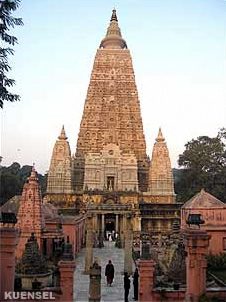|
The
Bhutan Temple in Bodhgaya
|
 |
Bhutan Religion |
|
 |
Bhutan Information |
|
|
 |
|
The
Mahabodhi temple - Renovating Bodh Gaya temple
|
 |
| Mahabodhi temple in Bodhgaya , Bihar, India |
The
major part of the restoration work, that of replacing old molded plaster
with new one, on the 52 meter high inward sloping spire of the Mahabodhi
Mahavihara in Bodh Gaya, India, is expected to be completed in a month
or two, according to a spokesman for the Bodh Gaya temple management committee.
"We
are expecting to complete the work by the end of January 2007," the spokesman
said.
Funded
by the Bodh Gaya temple management committee and carried out by the Archaeological
Survey of India, the major restoration work, being done after more than
120 years, began in 2002. The work had been stalled in 2004-2005 because
of dispute between the temple management committee and the Archaeological
survey of India. |
|
"We
know only that the Patna high court in Bihar ordered to continue renovation
work early this year," said venerable P. Seewalee Thero of Maha Bodhi society
of India in Bodh Gaya. He refused to give further details.
According
to venerable P. Seewalee Thero, it is a major face-lift after 1880 although
the government of India had done some repair work and enlarged the premises
of the Mahabodhi stupa in 1956 on the occasion of 2500th Buddha Jayanthi
celebrations.
It
is believed that the temple was badly ruined in the mid 19th century and
was extensively restored by the British archaeologists J.D. Beglar and
Alexander Cunningham in 1880. Much of the Mahabodhi temple's exterior actually
dates from that period.
According
to a devout Buddhist from Bhutan, Lam Kunzang, who always travels to Bodh
Gaya in winter, the renovation is symbolic of Lord Buddha's ever-presence
and his dharma.
Bodh
Gaya's spiritual history dates back to the 6th century B.C. when Prince
Siddhartha Gautama, at the age of 35 years, attained enlightenment under
the bodhi tree in the holy place where the Mahabodhi temple stands today.
History
has it that after attaining enlightenment, Lord Buddha spent seven more
weeks in meditation in seven different places around the bodhi tree.
But,
it was only during the reign of King Ashoka in the 3rd century B.C. that
this place came into prominence. King Ashoka first constructed the Vajrasana
or Dorjidhen and then built a stupa in veneration of the Buddha which remained
upto the 2nd century A.D.
The
Mahabodhi Mahavihara or more popularly known as the Bodh Gaya Temple or
the Great Stupa, is one of the shrines out of the 84,000 shrines erected
by King Ashoka. The Mahabodhi Mahavihara is the sole surviving example
of what was once an architectural genre.
Today,
the main attraction for pilgrims at Bodh Gaya was to worship at the Vajraseat
and the other six locations where the Buddha had meditated. Another attraction
was the Mahabodhi image, the statue in the Mahabodhi temple that was believed
to be the exact likeness of the Buddha himself.
The
Mahabodhi temple was declared a world heritage site by the UNESCO on June
27, 2002.
| Contributed
by Rinzin Wangchuk, KUENSEL, Bhutan's National Newspaper 2006 |
 |
| Information on Bhutan |
 |
|



